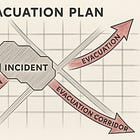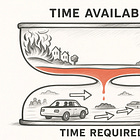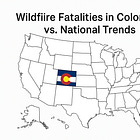Evacuation Resource Guide
Of all the decisions public safety leaders face during a disaster, few carry more weight or more risk than ordering an evacuation.
Done well, evacuations save lives and provide communities with a clear path out of danger.
Done poorly, they can create chaos, stretch resources to the breaking point, and erode public trust.
That duality—a critical life-safety option that is also incredibly complex—is what makes evacuation planning so important.
The articles, playbooks, and resources in this guide have been developed alongisde our clients as a supplemment to our project work, offering deeper context, case studies, and lessons that you can apply while developing an evacuation capability.
At The CP Journal, we exist to help leaders build organizations ready for anything.
Evacuation Planning Resources
Done well, evacuations save lives and provide communities with a clear path out of danger. Done poorly, they can create chaos, stretch resources to the breaking point, and erode public trust. That duality—a critical life-safety option that is also incredibly complex—is what makes evacuation planning so important.
In this article, I want to place evacuation into its broader context within disaster response and highlight three strategies that cities and counties can use when preparing for these complex operations.
At its core, every evacuation hinges on a single, straightforward question: do we have enough time to complete the process?
This article examines that elements that impact how long it takes for a community to evacuate once the decision has been made.
Though undeniably devastating, wind-driven fires provide public safety organizations a rare opportunity for proactive preparedness because the sustained high winds necessary for such fast-moving incidents to occur are also (often) well-forecasted.
This article used the January 2025 Los Angeles Fires as a case study of exceptionally clear, timely, and intense pre-incident warnings and messaging.
In recent years, wildfires have evolved from relatively predictable, forest-based events into fast-moving, wind-driven disasters that impact urban and suburban communities.
In wind-driven fire scenarios, evacuation is often the only realistic option for safeguarding lives. Traditional firefighting methods can be severely constrained when faced with high winds and rapidly spreading fire lines, forcing responders to prioritize rapid evacuation and life safety over property protection.
In Colorado, civilian wildfire fatalities overwhelmingly occur on residential properties, typically inside homes or attached structures such as garages. Nearly all fatal outcomes resulted from an inability or decision not to evacuate in time.
Drawing from incident records, after-action reports, and media accounts, this report summarizes where, when, and how wildfire fatalities have occurred, with a focus on evacuation timing and decision-making.
Looking for something else? Email The CP Journal | training@cp-journal.com






